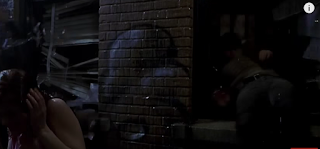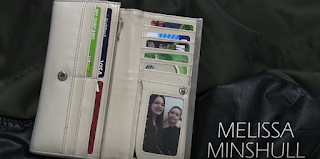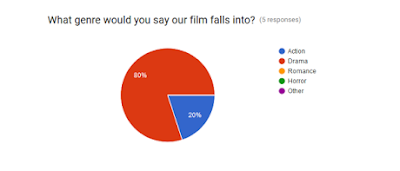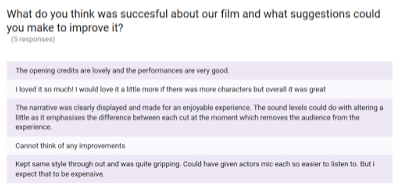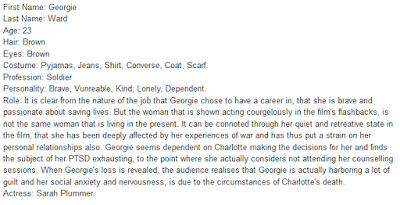Final cut on youtube
Showing posts with label Jasmine. Show all posts
Showing posts with label Jasmine. Show all posts
Sunday, 30 April 2017
Aftermath - Radio Trailer
The following link is a preview of the radio trailer for Aftermath:
Sunday, 23 April 2017
Evaluation 1
In what ways does the media product use, develop or challenge forms and conventions of real media products?
This year's project was to create a 5 minute short film, along with a radio trailer and poster to promote it. I found this year's task much more challenging than last year's as the film had to be much longer, meaning we had to write a longer script, and spend much more time filming and editing. The film we decided to make depicts the lead character, Georgie, attempting to overcome her PTSD after returning from the war.
Arguably, our film subverts some expectations of drama, as the ending is not exactly a happy one. Although Georgie begins her road to recovery, she loses her friend indefinitely, and is left alone. This subversion of convention can be seen in 'Titanic', as although it conforms to many aspects of the drama genre, it ends sadly with the death of the protagonist. Another influence of our film is 'Growth' by Elliot Gough, as it involves many similar themes, such as imaginary people. However, the film's main focus is a breakup, rather than a death.
Continuity -
One of the main difficulties we encountered was continuity and making sure everything was kept the same across the weeks of filming. The girl playing Charlotte changed her hair style and colour multiple times during the filming process, which proved challenging to accommodate, but we resolved this issue by re shooting some of the earlier scenes, with her hair covered.
Another continuity issue was the decorations in Georgie's house as it was Christmas when some of the scenes were filmed. Because of this, we had to re-shoot some of the interior scenes. Although seemingly problematic, re-shooting scenes allowed us to change other aspects we weren't happy with, such as lighting and background noise. Overall, this extra input allowed us to create a much better film in the end, and revealed that even with strategic planning, you can run into difficulties and experience errors.
In order to create sound continuity, we used sound bridges and dissolves between clips to allow a smoother transition from the noisy outside to the quiet inside scenes. Evidence of this can be found in our final film here.
This year's project was to create a 5 minute short film, along with a radio trailer and poster to promote it. I found this year's task much more challenging than last year's as the film had to be much longer, meaning we had to write a longer script, and spend much more time filming and editing. The film we decided to make depicts the lead character, Georgie, attempting to overcome her PTSD after returning from the war.
Genre -
In the planning stage, we decided we wanted to make a drama, which is why we chose centre the film around the aftermath of Georgie's tour of Afghanistan. This allowed us to capture the emotion surrounding the loss of her friend Charlotte, and explore a subject that, although affects many people, isn't often tackled by the media. By making our film a drama, we were able to explore PTSD, and how it affects people, in a respectful and sincere way.
I think our film fits the stereotype of a drama as it follows the life of a character, depicting a time of hardship and them trying to overcome it. Our film is also realistic, which fits into the stereotype of a drama. In the planning stages we considered the film to have a hybrid genre, drama and war. However, after some consideration we decided the film was better suited to being a pure drama, due to it's specific focus on the effects of war on Georgie's mental state, rather than her actual time on tour.
In the planning stage, we decided we wanted to make a drama, which is why we chose centre the film around the aftermath of Georgie's tour of Afghanistan. This allowed us to capture the emotion surrounding the loss of her friend Charlotte, and explore a subject that, although affects many people, isn't often tackled by the media. By making our film a drama, we were able to explore PTSD, and how it affects people, in a respectful and sincere way.
I think our film fits the stereotype of a drama as it follows the life of a character, depicting a time of hardship and them trying to overcome it. Our film is also realistic, which fits into the stereotype of a drama. In the planning stages we considered the film to have a hybrid genre, drama and war. However, after some consideration we decided the film was better suited to being a pure drama, due to it's specific focus on the effects of war on Georgie's mental state, rather than her actual time on tour.
Some of the main conventions of drama are:
- Realistic characters, settings and stories - We used the realistic setting of a house and a psychologist's office, along with the storyline of a woman suffering from mental illness.
- Portrays a journey of character development - Although our film is short, it depicts part of Georgie's recovery from PTSD and her realisation that Charlotte is a figment of the imagination.
- Centred around conflict, hardships or pain - Georgie faces internal conflict with her own mind, which manifests itself externally through her 'arguments' with Charlotte.
- A form of realisation at the end/happy ending- Georgie comes to realise that Charlotte is part of her imagination with the help of the psychologist.
Arguably, our film subverts some expectations of drama, as the ending is not exactly a happy one. Although Georgie begins her road to recovery, she loses her friend indefinitely, and is left alone. This subversion of convention can be seen in 'Titanic', as although it conforms to many aspects of the drama genre, it ends sadly with the death of the protagonist. Another influence of our film is 'Growth' by Elliot Gough, as it involves many similar themes, such as imaginary people. However, the film's main focus is a breakup, rather than a death.
 |
| Poster for 'Growth' by Elliot Gough |
 |
One of the main difficulties we encountered was continuity and making sure everything was kept the same across the weeks of filming. The girl playing Charlotte changed her hair style and colour multiple times during the filming process, which proved challenging to accommodate, but we resolved this issue by re shooting some of the earlier scenes, with her hair covered.
 |
| We accommodated this by covering her hair |
 |
| Brown hair by the end of filming |
In order to create sound continuity, we used sound bridges and dissolves between clips to allow a smoother transition from the noisy outside to the quiet inside scenes. Evidence of this can be found in our final film here.
Some continuity errors in real life media products include:
- The iconic scene from 'Spider-Man' (2002), where the window is broken, and then not broken in the next scene.
- Merry and Pippin are tied up in 'The Lord of the Rings: The Two Towers' (2002), when they escape to the woods, they are untied and the ropes are gone.
- The 'divine intervention' scene in 'Pulp Fiction' (1994), when the gangsters are left unharmed by the shower of bullets heading their way, but with a keen eye, it can be seen that the wall behind them was filled with bullet holes before any shots were fired.
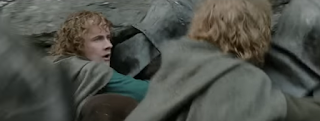
Music is another way continuity can be broken, for example, if the tone of the music doesn't fit with the film. I feel that the music in our film works well, as we did a lot of research and trial and error. For this evaluation I decided to research how changing the soundtrack to a film can also change the tone. Click here and here for the videos I found. One video is an example of changing the music of real films, and one is an independent example.
Influences-
Inspired by the real media product 'Stray Dog' by Bertie Gilbert, we used iconography through mise en scene to provide insight into the lives of the characters in the title sequence. Including this at the start of the film allows a relationship to be established between the two characters right away, and the isolated placement of each object sets the tone of the film, reinforcing Georgie's loneliness and suffering. Although it was difficult to capture the complexity of Georgie's
emotions in still images, we decided this would be a simplistic and tasteful way to tie together the names of the people in the group and the story's background information. The empty chair symbolises Charlotte's death and the emptiness now felt by Georgie, and the wallet with the photograph is used to establish a relationship between the characters immediately. Again, our inspiration came from the short film 'Stray Dog', which we found inspiring as it was made by someone a similar age to us, but using professional equipment, and being a real media product. Stray Dog film
We were influenced by the real media product 'Our Girl' as it has a military theme. A hostage situation is referenced at the end of our film, and hints at the reason Charlotte didn't come home with Georgie. Our Girl clip. We were also influenced by an episode of EastEnders that explores mental illness and loss. However, we chose to show Georgie dealing with her emotions in a more positive way, by accepting help, rather than turning to drink. We did this as we wanted to create a sense of hope for sufferers, and education for non-sufferers, in the short time limit we had. EastEnders Clip
How does our film provide entertainment?
People are often left feeling unhappy and unfulfilled in life because of things like social tension, inadequacy and abstinence. Richard Dyer suggests that consuming media can counteract these effects by providing entertainment and escapism through depicting:
- Energy - This helps to restore the vitality stripped by urban life and working hard. Films often depict human power and activity, which can be inspiring and increase the energy levels of the audience. An example of this is Katniss Everdeen in the Hunger Games, as she fights for what she believes in and tries to survive, sparking energy in the audience as they progress through the film with her. The Hunger Games Trailer. Our film provides energy by drawing in the audience's interest and restoring faith surrounding support for mental health and recovery, as the audience wants Georgie to get better. Additionally, the dream sequence at the begining provides energy through the chaotic feel created.
- Abundance - This refers to having enough to spare, and the enjoyment of material things. Many people use media as a way of supplementing the lack of luxury in their lives. By seeing people with riches and material possessions in films, they themselves feel as though they have it, and experience what it is like to have abundance. An example of this in a film is The Princess Diaries, as it explores many girls' fantasises of becoming a princess and having a luxurious lifestyle. The character of Mia is relatable as she begins as a normal girl, but the dramatisation of her becoming a princess allows the audience to experience what something so exciting might feel like, which creates a positive feeling. The Princess Diaries Trailer. In our film, Georgie is presented as a normal girl, making it easy for the audience to relate to her, but suffering from a mental health condition. Her PTSD is reassuring for other suffers as the film depicts the beginning of her recovery, and provides information for non-sufferers. It also shows people what it would be like to suffer from PTSD, reminding them that their lives could be much worse, so allowing them to appreciate their own lives more.
- Intensity - This refers to having excitement in life, which many people lack as they get pulled into the routines of everyday life. Consuming media products, such as action or thriller films, substitutes the lack of interesting events happening in the audience's lives, and allows them to feel a 'buzz'. A real life film that uses Intensity is 'Kong: Skull Island', as it depicts a mission to a remote island, with the crew unaware of what they will find. This situation is something most people will never experience themselves, so watching such events in the media substitutes this desire for excitement and adventure. Kong: Skull Island Trailer. Like 'Kong: Skull Island', our film has an element of magical-realism, as although the story is realistic and follows the conventions of a drama, the fact imagined Charlotte can be seen on screen adds a fantasy element. The dream sequence at the beginning of our film creates Intensity as it hints at violence, and depicts a war zone, which is often presented as exciting and intense in the media, and is somewhere many people will never visit.
- Transparency - This refers to being open and honest and effectively communicating, which counteracts parts of life such as manipulation, politics and democracy and advertising. In our film, Georgie is guarded about her PTSD, but Charlotte is used as a tool to explain Georgie's emotions and provide information to the audience. This transparency is what allows the film to work, as without it, the audience would easily become confused. Additionally, mental illness is often stigmatised, so by making it the centre of our short film, we hoped to create some transparency around PTSD, educating non-sufferers, and providing hope for sufferers in the audience. In order to make our depictions as accurate as they could be, we did research into the topic and how it affects people's lives.
- Community - Community creates a sense of togetherness and belonging, which offers comfort and support to the audience, especially those who lack close family/friends, or are part of high-rise urban life. A sense of community is created in our film as Georgie receives support from the psychiatrist regarding her PTSD, and reminds the audience that there is always someone there to help. However, Charlotte's presence highlights some sad truths regarding our society, that Georgie is so easily able to isolate herself, with only her unstable mind and figments of imagination for comfort.
 |
| Me setting up the camera to film audience feedback |
Saturday, 22 April 2017
Wednesday, 19 April 2017
Evaluation 3
Our intention was to create a 5 minute fiction film that would explore PTSD and make the audience empathise with the character of Georgie. We made several changes to the film in response to audience feedback, such as adding an extra scene of dialogue in the hallway, and cutting out the bus scene. Many audience members said they felt there was too much walking, and not enough dialogue, which is why we made those changes.
How did we create meaning?
We used a two shot of Georgie and Charlotte in the kitchen, but positioned them at either end of the shot to convey how Georgie has become detached from herself and reality through her mental illness, and to reinforce the physical separation of the two characters. The fact it is a two shot highlights Georgie's reluctance to let go of Charlotte, and presents her trying to keep the memory of Charlotte close.
We used a slight low angle on the shot of Charlotte on the stairs to present the degree of power she holds over Georgie's life. Although Charlotte is not really there, the effect Charlotte's death has had on Georgie is holding her to ransom and stopping her from moving on. Piano music is used throughout to add a sense of melancholy, which, when teamed with the slow paced editing throughout, creates a sluggish feel, mirroring Georgie's emotions.
Elliptical editing was used to cut out some of the less interesting parts, such as walking, as these non-essential scenes slowed down the pace of the film and made it less engaging. This can be seen from the first rough cut to the final project. I think that including more elliptical editing was a good idea as it made our film much more enjoyable to watch, and stopped some parts dragging. Click here for evidence of elliptical editing. Arguably, the car acts as a partial wipe, and allows a smooth transition into the next scene. We used backgrounds with similar colours, stone, blue and yellow, to again, allow a smooth transition between shots.
An over the shoulder shot is used to show Georgie's therapy letter. We used this prop to reinforce where she was and the significance of this meeting for her recovery. This is also shown in the close up of her phone, which shows a reminder text regarding the appointment. This reinforcement of the therapy session throughout depicts it as an important event and pivotal point in Georgie's recovery. The mis en scene of this letter is paired with the posters on the wall in the therapy room to give a more convincing look to the set.
These particular shots and edits were used to add emotion to the film. In the research video 'How did Aftermath make you feel?', it is reported that the emotion surrounding Georgie's PTSD was successfully translated to the audience. One of the main reasons for this was the shots and edits used, including the ones depicted above, and the close ups of Georgie's face at the beginning and end.
Questionnaires:
Below is our video questionnaire, which is the first bit of audience feedback we received. We asked 5 people in our target demographic. All were students at Barnsley College, and were between the ages of 15 and 20.
Most people said they liked the sound of our film, and would watch it. Many people said You tube would be a good place to exhibit the film, which we agree with as You tube is a good place to showcase independent films. A lot of people said they would expect to see the film in the cinemas, but our budget would not allow for this scale of distribution. If we were to re-make the film professionally, it may be distributed to cinemas.
Looking at the results as a whole, we received much more positive feedback in the later questionnaires. This is probably down the the changes we made, such as cutting out scenes of walking and including more dialogue. In the final questionnaire, 100% of people gave the film 8 or above out of 10. If we were to generalise this to the rest of the population, it would suggest success for our film.
In the final questionnaire, 100% of people said they understood the plot, which is an improvement from the 80% of people who said they understood it in the second questionnaire. This shows we were successful in developing the film into a much better piece.
Most people said they thought our film was a drama,which corrilates with the genre we intended our film to be. 20% of people said they thought our film fell into the action genre, which is probably because of the military theme and dramatic dream sequence at the beginning. No one said the film was romance, horror or other, which shows we were effective in translating our message to the audience.
How did we change the film in response to audience feedback?
The genre of our film was understood to be a Drama which correlates with the one intended for Aftermath. This shows that our film has been successful in displaying the conventions of the genre, such as using the army jackets and the sound of gunshots in the opening scene, and so suits the context of the film. People generally expected to see our film in the cinema or through film festivals, which is what we too expected for our film, as Dramas are a popular and successful genre. However, the low budget of our film would probably mean it would have to be an independent project, and the most likely place to distribute it would be to Youtube.
How did our film make the audience feel?
87% of the people that watched our film understood it's plot and the twist that came at the end of the clip. Georgie's PTSD caused her hallucinations, which we attempted to represent through Charlotte's character. We tried to make Charlotte's death subtle in order to capture the sensitive and heartfelt nature of Aftermath. Due to the limited timeframe we had, we had to make the ending of the film more prominent so that the message could be understood better and be more impactful. Most of our responses said that they wish that Charlotte's status had been referenced earlier in the film so that the ending was more clear, so we added some extra scenes to show Charlotte jumping around the house, such as Charlotte's sudden appearance in the kitchen, through the use of jump cuts in editing.
We used music to create a melancholy tone, and many people agreed that the music fitted well. Some people suggested we remove the clock ticking from the counselling scene as it was distracting and made our actors difficult to hear, which we agreed with, so removed for the final cut. They also suggested reducing the volume or replacing the sound of ringing after the gun is fired in the flashback scene, which smoothed the transition from the war scenes to the bedroom scenes. All of these suggestions were very helpful and helped to make our final piece successful.
I decided to gather some final feedback from social media sites on how our film made people feel. Some responses are evidenced below:
Overall, considering all the feedback we have received, I believe our film to be a success as we have achieved everything we aimed to. Our intention was to create a 5 minute fiction film that would explore PTSD and make the audience empathise with the character of Georgie, which I believe we have done. This is supported by the questionnaires and graphs, as well as social media feedback.
How did we create meaning?
We used a two shot of Georgie and Charlotte in the kitchen, but positioned them at either end of the shot to convey how Georgie has become detached from herself and reality through her mental illness, and to reinforce the physical separation of the two characters. The fact it is a two shot highlights Georgie's reluctance to let go of Charlotte, and presents her trying to keep the memory of Charlotte close.
We used a slight low angle on the shot of Charlotte on the stairs to present the degree of power she holds over Georgie's life. Although Charlotte is not really there, the effect Charlotte's death has had on Georgie is holding her to ransom and stopping her from moving on. Piano music is used throughout to add a sense of melancholy, which, when teamed with the slow paced editing throughout, creates a sluggish feel, mirroring Georgie's emotions.
Elliptical editing was used to cut out some of the less interesting parts, such as walking, as these non-essential scenes slowed down the pace of the film and made it less engaging. This can be seen from the first rough cut to the final project. I think that including more elliptical editing was a good idea as it made our film much more enjoyable to watch, and stopped some parts dragging. Click here for evidence of elliptical editing. Arguably, the car acts as a partial wipe, and allows a smooth transition into the next scene. We used backgrounds with similar colours, stone, blue and yellow, to again, allow a smooth transition between shots.
These particular shots and edits were used to add emotion to the film. In the research video 'How did Aftermath make you feel?', it is reported that the emotion surrounding Georgie's PTSD was successfully translated to the audience. One of the main reasons for this was the shots and edits used, including the ones depicted above, and the close ups of Georgie's face at the beginning and end.
Questionnaires:
Below is our video questionnaire, which is the first bit of audience feedback we received. We asked 5 people in our target demographic. All were students at Barnsley College, and were between the ages of 15 and 20.
 |
| Results gathered from the first questionnaire |
 |
| Results gathered from the final questionnaire |
In the final questionnaire, 100% of people said they understood the plot, which is an improvement from the 80% of people who said they understood it in the second questionnaire. This shows we were successful in developing the film into a much better piece.
Most people said they thought our film was a drama,which corrilates with the genre we intended our film to be. 20% of people said they thought our film fell into the action genre, which is probably because of the military theme and dramatic dream sequence at the beginning. No one said the film was romance, horror or other, which shows we were effective in translating our message to the audience.
How did we change the film in response to audience feedback?
In response to feedback, we made alterations to the sound levels in order for the dialogue to be easier to hear. As a consensus, the audience felt that there could have been more close ups included in our film in order to create more intimacy, and allow the emotions of the characters to translate more effectively. In response to this, we added close ups getting tighter in around Georgie's face in the final scene. Additionally, the audience commented on the sound levels throughout, with one suggesting we used external mics, which is something to consider next time we produce a film.
The genre of our film was understood to be a Drama which correlates with the one intended for Aftermath. This shows that our film has been successful in displaying the conventions of the genre, such as using the army jackets and the sound of gunshots in the opening scene, and so suits the context of the film. People generally expected to see our film in the cinema or through film festivals, which is what we too expected for our film, as Dramas are a popular and successful genre. However, the low budget of our film would probably mean it would have to be an independent project, and the most likely place to distribute it would be to Youtube.
Changes can be seen between the different cuts of the film:
How did our film make the audience feel?
87% of the people that watched our film understood it's plot and the twist that came at the end of the clip. Georgie's PTSD caused her hallucinations, which we attempted to represent through Charlotte's character. We tried to make Charlotte's death subtle in order to capture the sensitive and heartfelt nature of Aftermath. Due to the limited timeframe we had, we had to make the ending of the film more prominent so that the message could be understood better and be more impactful. Most of our responses said that they wish that Charlotte's status had been referenced earlier in the film so that the ending was more clear, so we added some extra scenes to show Charlotte jumping around the house, such as Charlotte's sudden appearance in the kitchen, through the use of jump cuts in editing.
We used music to create a melancholy tone, and many people agreed that the music fitted well. Some people suggested we remove the clock ticking from the counselling scene as it was distracting and made our actors difficult to hear, which we agreed with, so removed for the final cut. They also suggested reducing the volume or replacing the sound of ringing after the gun is fired in the flashback scene, which smoothed the transition from the war scenes to the bedroom scenes. All of these suggestions were very helpful and helped to make our final piece successful.
I decided to gather some final feedback from social media sites on how our film made people feel. Some responses are evidenced below:
Overall, considering all the feedback we have received, I believe our film to be a success as we have achieved everything we aimed to. Our intention was to create a 5 minute fiction film that would explore PTSD and make the audience empathise with the character of Georgie, which I believe we have done. This is supported by the questionnaires and graphs, as well as social media feedback.
Tuesday, 18 April 2017
Wednesday, 29 March 2017
Final Questionnaire Responses
The majority of people who answered our questionnaire were female in a 3:2 ratio.
There was a 4:1 split with the different age gaps, with the majority being with within the 15-17 age bracket. This implies that the final cut was watched by people within our intended demographic.
Upon asking our audience if they enjoyed the film, the majority gave a score of eight, while two gave a score of nine. This conveys that the film was enjoyable and easy to follow, this is what we were intending to do within our storyline, for keeping it intriguing, making people want to continue watching.
Everyone who took part in our questionnaire said that they understood the plot of our film. This means that our plot was easy to follow, and also that we conveyed the themes and messages in a way that was easy to follow.
A ratio of 4:1 thought our film fit a 15 certificate, while one thought it fit a 12 certificate. This means that we added the appropriate qualities for a 15 certificate, this conveys that our research into film certificates was successful.
4:1 ratio of the people who answered our questionnaire said that they thought the genre of our film was action and drama. This is good as they are the two main genres we were trying to portray within out film.
Upon asking where people would expect to see our film there was a 3:1:1 split within the answers. Three people suggested that our film would be good on YouTube, which is the site we chose to host our short film. The other two suggestions were at the cinema and on TV these could potentially be possible, if we had the budget to approach them, however we only had a very small budget meaning that YouTube was the best option as it if free.
Everyone who answered the questionnaire said that the music we chose suited the overall tone of our film. We were happy with this result as we took caution and caution when picking the music for our film, ensuring that it fit to our film. We also altered the music from our rough cut, with the response of the audience questionnaire we carried out previously. Some of the comments on the music were things such as 'The music used has a very melancholy tone which fits with the flashbacks' and 'I feel as though you spent time on the music and a good soundtrack and add a lot to a film', this conveys that the time we spent selecting the music was worth it.
We also asked if there were any improvements that we could make to our film for future reference, the feedback which we received were things such as 'the opening credits are lovely and the performances are very good', 'the narrative is clearly displayed and made for an enjoyable experience'. We did however receive some constructive criticism, for example, 'the sound levels could do with altering a little' and 'could have given actors mic each so easier to listen to'. We took these into consideration however the mics would have taken us out of our budget.
Tuesday, 28 March 2017
Final Questionnaire
Here is the link to our final questionnaire for Aftermath after making changes to our film from the last reflection on audience responses. We asked questions that would tell us what our potential audience thought was successful about the production of our film and any suggestions they would make that could have improved the film even further. Most of all, we wanted to discover whether they thought our film had met it's targets of being a Drama that was suitable for a fifteen age rating.
Link to the Questionnaire
Link to the Questionnaire
Monday, 27 March 2017
Shooting Pack 7 - Extended Letter Box scene
The following is a list of things we needed/used during filming of our extended letter box scene.
Shot List
This scene was added after reading through our audience feedback, that said we needed an extra scene to further explain the letter coming through the letter box and Gerogie jumping, with her PTSD. We used a range of medium to long shots, with close ups and over the shoulder shots.
Storyboard
Between these two scenes within the house and walking to therapy we added in the scene where georgie went to pick up the post, and had a conversation with Charlotte about her anxiety, this scene further establishes the relationship between them, but also relefcts the severity of her illness.
Script
Props
Character Profiles
Equiptment
Subscribe to:
Posts (Atom)


